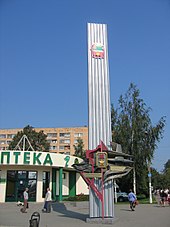Naro-Fominsk
| city
Naro-Fominsk,
Наро-Фоминск
|
||||||||||||||||||||||||||||||||||||||||
|
||||||||||||||||||||||||||||||||||||||||
|
||||||||||||||||||||||||||||||||||||||||
| List of cities in Russia | ||||||||||||||||||||||||||||||||||||||||
Naro-Fominsk ( Russian Наро-Фоминск ) is a city with 64,665 inhabitants (as of October 14, 2010) in Moscow Oblast , Russia . It is located 70 km southwest of Moscow , on the Nara River and near the Russian M3 highway from Moscow to Kiev .
history
Naro-Fominsk emerged from two villages called Fominskoje and Malaya Nara . Fominskoje was first mentioned around 1328, which is why this year is also considered the year the city was founded. The village of Malaya Nara, whose name was derived from the Nara river was, in the 17th century owned by Savva Monastery of Zvenigorod .
Until the 19th century, the two villages had no economic or other importance. On October 22nd, 1812, during the Russo-French War and two days before the Battle of Malojaroslavets , Napoleon Bonaparte and his army stopped in Fominskoye while retreating from Moscow, and then moved towards Malojaroslavets (50 km from Naro-Fominsk) .
In 1840 the first industrial enterprise was established in Malaja Nara with the paper mill of the merchant Skuratow. Since then, the two places have grown together to form a workers' settlement which at the end of the 19th century already had a school, a hospital and a pharmacy. In 1925, the two villages were officially united to form the Naro-Fominskoje workers' settlement, which one year later became the city of Naro-Fominsk.
During the Battle of Moscow in World War II , Naro-Fominsk was hotly contested in late 1941 and was partially destroyed in air raids by the Wehrmacht .
Population development
| year | Residents |
|---|---|
| 1926 | 15,900 |
| 1939 | 31,613 |
| 1959 | 35,419 |
| 1970 | 48,651 |
| 1979 | 55,858 |
| 1989 | 58,292 |
| 2002 | 70,475 |
| 2010 | 64,665 |
Note: census data (1926 rounded)
Economy and Infrastructure
Naro-Fominsk is an important center of the textile industry. There is also a plant of the packaging manufacturer Rexam in the city .
The city has a railway connection on the main line from Moscow to Kiev. There are regular train connections from Nara station to Moscow ( Kiev station ), Obninsk or Kaluga, among others .
The Military Academy of the Russian Armed Forces is located in Naro-Fominsk , where the politician and Lieutenant General Alexander Lebed, among others , completed his officer studies.
Town twinning
-
 Daugavpils , Latvia
Daugavpils , Latvia
Individual evidence
- ↑ a b Itogi Vserossijskoj perepisi naselenija 2010 goda. Tom 1. Čislennostʹ i razmeščenie naselenija (Results of the All-Russian Census 2010. Volume 1. Number and distribution of the population). Tables 5 , pp. 12-209; 11 , pp. 312–979 (download from the website of the Federal Service for State Statistics of the Russian Federation)
Web links
- Unofficial website (Russian)
- Naro-Fominsk on mojgorod.ru (Russian)





